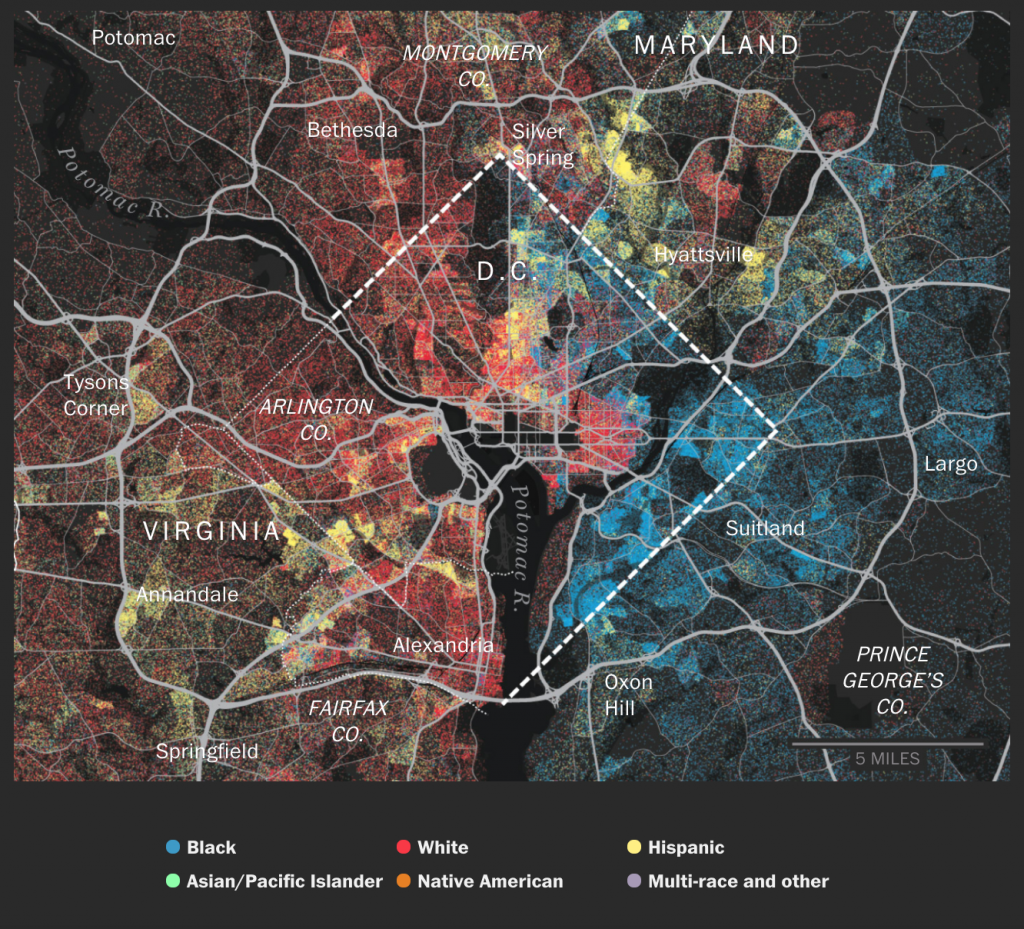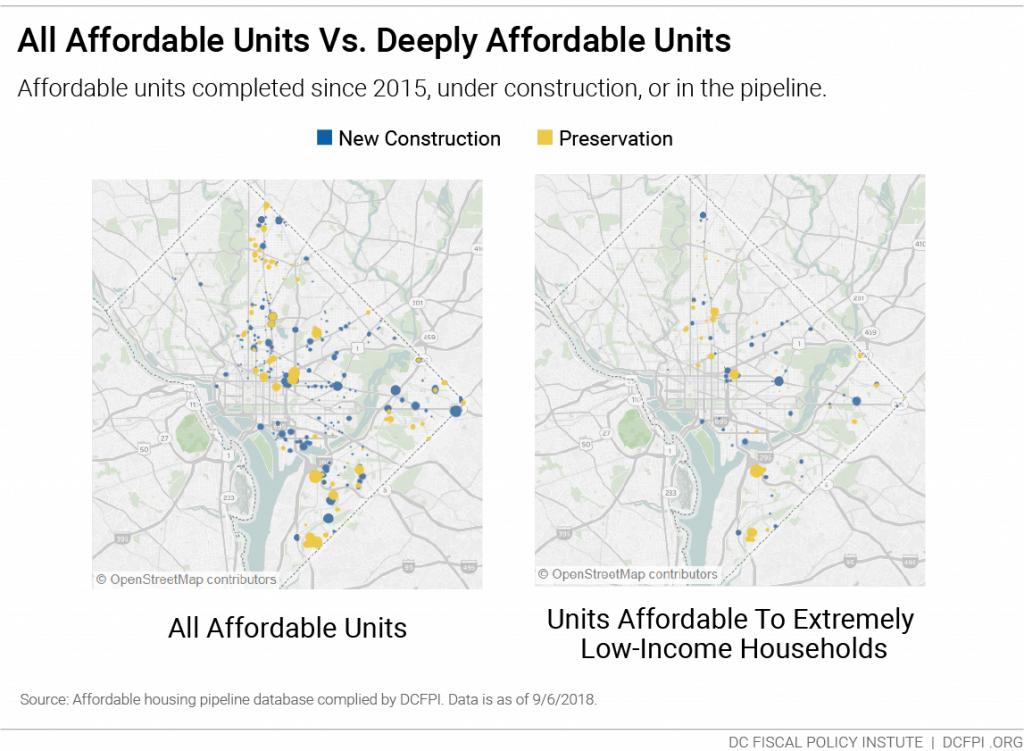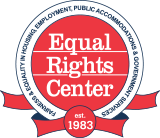Source of Income Discrimination Perpetuates Racial Segregation in DC
By Nick Adjami
August 19, 2020
In 2015, Washington, DC was ranked the sixth most segregated city out of the one hundred most populous cities in the United States. As the map below shows, the city’s white residents live primarily in the Northwest quadrant, while its Black residents reside mainly in the Northeast and Southeast. In 2019, DC’s draft Analysis of Impediments to Fair Housing Choice found hypersegregation in twelve neighborhoods East of the Anacostia River to be “as severe as South African apartheid.”
 Source: Washington Post
Source: Washington Post
Where a person lives has wide-reaching implications. It determines one’s access to resources and life outcomes like educational achievement and life expectancy. In DC, those who live East of the Anacostia River have less access to public transit, have more difficulty accessing healthy food, are more likely to develop asthma, and are more likely to be exposed to violent crime.
DC’s geographic racial divide and corresponding disparities did not happen by chance but are the result of a long history of discrimination against the city’s Black residents. DC is not alone in this. Nationwide policies like redlining, whereby communities of color were marked as “hazardous” for investment and cut off from access to credit, and practices such as racially restrictive covenants, which barred people of color from living in certain properties or neighborhoods, isolated Black Americans from opportunity. These systems entrenched geographic and socio-economic racial gaps that still persist today. In DC, white households have a net worth 81 times greater than Black households.
DC also suffers from a shortage of affordable housing. Over recent years, rent prices have skyrocketed while wages have stagnated. In 2002, nearly 60,000 apartments in the District were available for less than $800 per month. By 2013 that number had dropped to just 33,000, even adjusting for inflation. The affordable housing that remains is clustered in neighborhoods designated “racially and ethnically concentrated areas of poverty” by the U.S. Department of Housing and Urban Development (HUD), and even those units are often too expensive for the city’s extremely low-income residents.
 Source: DC Fiscal Policy Institute
Source: DC Fiscal Policy Institute
This lack of affordable housing has led the DC Fiscal Policy Institute to conclude that “subsidized housing,” such as that provided by the Housing Choice Voucher Program, “is now virtually the only source of inexpensive apartments.” The Housing Choice Voucher Program allows program participants to rent units that they would otherwise not be able to afford by subsidizing all or part of their rent costs.
There are currently over 10,000 Housing Choice Vouchers in use in DC, over 90 percent of which are being used by Black families. By virtue of assisting DC’s lowest-income residents, many of whom are Black, the Housing Choice Voucher Program has the potential to reverse patterns of segregation and disadvantage by facilitating mobility to wealthier neighborhoods with greater access to opportunity. In DC, the value of the voucher varies by neighborhood, meaning a voucher being used in a more expensive area will cover a higher cost rent. In 2017, the DC Housing Authority (DCHA) raised the payment standards for voucher holders in some neighborhoods to up to 175% of the Fair Market Rent (FMR). FMR refers to the estimated amount that a property in a given area typically rents for. These increased, localized payment standards ensure that voucher holders can afford rents in most neighborhoods, including those rich with opportunity. If DCHA used the payment standards established by HUD, which are determined by zip code as opposed to neighborhood, voucher holders would only be able to afford housing in a small percentage of DC neighborhoods, mostly in areas with limited access to opportunity. Similarly, if DCHA had not increased their standards in 2017, voucher holders would not have access to many of the wealthier neighborhoods that they now do.
Unfortunately, voucher holders face another barrier to living in these neighborhoods: landlords. In 2018 alone, the ERC identified about 130 advertisements for properties in the District that made statements such as “No vouchers accepted” and “No section 8.” Source of income discrimination is illegal in DC, meaning housing providers cannot legally refuse to rent to someone based on their use of a housing voucher (or any other legal source of income) to pay rent, but clearly landlords sometimes violate the law.
Outright refusals to accept vouchers are straightforward examples of likely discriminatory behavior, but sometimes the offenses are less obvious. Through a testing investigation, the Equal Rights Center recently identified that Vaughan Place Apartments in Northwest DC has told prospective tenants that their property has not been pre-approved by the DC Housing Authority, and they therefore cannot rent to voucher holders. While this explanation might sound convincing to a prospective tenant, the DC Housing Authority does not actually have a pre-approval process. Creating excuses to avoid renting to voucher holders constitutes illegal source of income discrimination in DC, just the same as refusing them outright does.
Vaughan Place Apartments is not alone in this behavior. Last month, the DC Attorney General’s Office filed eight lawsuits against sixteen real estate companies and professionals for posting allegedly discriminatory advertisements with language such as, “NOT APPROVED for Voucher Program of DC Housing.”
Source of income discrimination is contemptible in its own right – voucher holders deserve access to safe, quality housing just like non-subsidized renters – but is especially nefarious for the role it plays in upholding racial segregation in DC. Over 90 percent of voucher holders in DC are African American, despite making up only 45.5 percent of the city’s population. As a result, a DC housing provider who refuses to rent to voucher holders is 71 times more likely to exclude African American renters than white renters. Clearly, discrimination against housing voucher holders is race discrimination, as well as source of income discrimination, in DC.
Landlords frequently cite paperwork and inspections required by housing authorities as hassles that discourage them from accepting voucher holders as tenants, but sometimes these supposed concerns are actually smokescreens for racial prejudice. Researchers in a 2018 study on landlords’ attitudes toward voucher holders found it “difficult to disentangle the landlord’s actual negative experiences with voucher tenants from their prejudices.” One landlord they interviewed said of tenants with vouchers, “I was raised in a decent background. Most of them aren’t.”
Ultimately, when housing providers in DC refuse to rent to voucher holders, their reasons for doing so do not matter. Whether they are explicitly racially motivated or just want to avoid paperwork, the result is the same: Black families remain segregated in areas of concentrated poverty and limited opportunity. The Housing Choice Voucher Program can and should be a tool used to desegregate DC and correct the harms done by decades of racist policy, and DCHA has made great strides to achieve this goal, but landlords who illegally reject voucher holders continue to stand in the way. It is past time for housing providers to comply with the law and do their part to advance housing justice across the District.
———
If you believe you may have experienced discrimination in housing, you can contact the Equal Rights Center. To report your experience, please call 202-234-3062 or email info@equalrightscenter.org.

